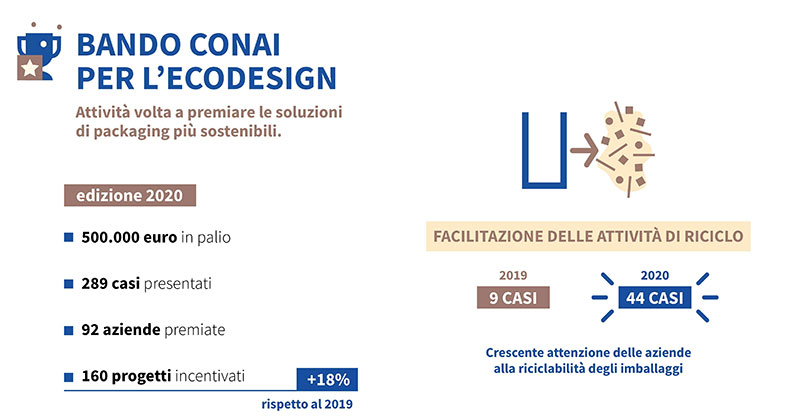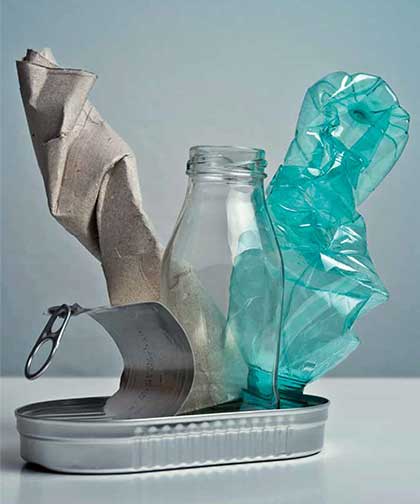ECO-DESIGN: CONAI’s call for proposals episode 2
A growing award and from this year open to all operators of the packaging supply chain, with an additional mix of authoritative partners: this is the CONAI Contest 2021.
We talked about it with Simona Fontana, head of the Consortium's Study Center, who traces the stages of an initiative that, starting as a survey, has become an instrument of support and promotion for companies that know how to combine environmental awareness with economic feasibility.
Stefano Lavorini
The CONAI Contest has such a long history that not even the pandemic has been able to stop it: it is no coincidence that the 2021 edition confirms the positive trend in terms of submissions, with a 10% increase in the number of case submissions and the number of companies involved (156), protagonists of an initiative that once again shows renewal.

«The year 2021 marks a new, important paradigm shift, with updates consistent with regulatory, technical and system evolution», explains Simona Fontana, head of the CONAI Study Center. «The main change concerns the fact that packaging subject to the contribution of other EPR systems can also be entered, albeit without any recognition of an economic nature. And again for the first time, we have provided for the possibility of accepting cases with a change of material, provided, however, that they ensure an improvement in terms of reuse and recyclability».
However, one of the strengths of the call for proposals has been confirmed, namely the evaluation of how packaging can be improved. Therefore, cases that facilitate recycling are admitted, with a positive LCA indicator among those considered (in terms of CO2 emissions, energy and water consumption) to be added to a positive result in terms of second raw material generated.
On the whole, this is an approach developed over years of toil, which is able to accurately and reliably define the entries worthy of receiving the 500,000 euros of economic incentives made available.
A rigor that has not gone unnoticed and is also highlighted by the quality of a multi-composite jury.
«The packaging entered is, in fact, first analyzed and evaluated through a simplified LCA analysis; only those that generate overall environmental benefits are evaluated according to eco-design levers activated by a Technical Committee made up of representatives of CONAI and of supply chain consortia, while the 5 special prizes for the circular economy are chosen by the enlarged Technical Committee: a panel made up, in addition to long-standing supporters such as Altroconsumo and the magazine ItaliaImballaggio (Pack-Media), of representatives of the Milan Polytechnic, the Turin Polytechnic, the IUAV University of Venice, the University of Bologna and Legambiente. And it is precisely this last that, from this year, will sign a special mention to one of the awarded cases for circular innovation.
After the evaluation, a ranking will be defined with all the award-winning cases, subject to verification by a third-party certification body».

In the beginning was the Prevention Dossier…
The CONAI Contest that we know today is the result of the numerous experiences gathered since the first Prevention Dossier in 2001.
«Originally - recalls Fontana - it was a triennial collection of best practices and virtuous experiences on the subject of packaging prevention, which did not focus on design, but limited itself to measuring the savings of resources in percentage terms. In other words, a snapshot of the state of the art of the market and technology».
In 2010, the model evolved, introducing more precise measurement parameters: it was the time of the evaluation of the environmental impact of packaging through LCA analysis, which better responded to regulatory changes and the growing sensitivity of consumers. And so, talk of eco-design began even then.
«Since we didn't have a scientifically defined evaluation grid available until that moment - she emphasizes - we looked to LCA, introducing for the first time a scientific method with which to measure the effects of preventive actions on packaging in terms of CO2 emissions, energy consumption and water consumption. This was an important step, a real novelty at the time, when LCA was only discussed in specialized circles. The introduction of this evaluation system was an intuition of CONAI, with the aim of establishing rules, codifying assumptions, sharing a path, defining what was to be measured and how, within what perimeter.
A work of synthesis that has gone beyond the initial objectives, and that has led to the definition of a new "open" tool, the Eco Tool, which not only allows CONAI to correctly evaluate the cases presented by the companies, but also allows the companies themselves to make their own strategic choices in terms of sustainability.
In short, we have gone from describing virtuous cases to designing a dynamic context».
And then the Call for proposals became reality

CONAI continues on the road to innovation, convinced that companies must be encouraged and enhanced in this path.
«2013 marks another turning point; it is the year, in fact, of the first edition of the Conai Contest, which rewards the improvement actions implemented by producers and users of consortium packaging, in good standing with the declaration and payment of the environmental contribution (CAC). Going beyond the logic of "simple" prevention, we now look at packaging as the protagonist of the circular economy. At the center is the packaging released for consumption in Italy, developed on the basis of a design consistent with the levers of eco-design, another theme that Conai has had the merit of enhancing».
Saving of raw materials, use of recycled material, simplification of the packaging system, optimization of logistics, reuse, facilitation of recycling activities, optimization of production processes: these are the requirements that, since then, are updated and revised every year.
«The Dossier, the Eco Tool, the Notice, the guidelines for eco-design are now tools that make CONAI a supporter in the path that companies want to take to improve the environmental sustainability of their packaging».
The measure of success
History and model of cooperation would not be enough, if there was not also a positive feedback from companies: from the first edition to today, the cases presented and admitted have quadrupled, with an increase of 18% in the period 2019-2020 alone. Last year, 160 projects were awarded, of which 44 focused on recyclability, demonstrating how much the circular economy has entered into daily practice.
«The end of lifecycle management of a product implies reasoning and acting upstream, then in the design phase - remarks Fontana - so that the impact of the management of packaging released for consumption is reduced downstream, fielding a real strategic approach to the issue of sustainability».
Talking about recycling, you need to evaluate the system's capacity to absorb the material, activating a realistic path with respect to existing plants. Therefore, there must be a recycling circuit of materials on an industrial scale, with quantitative and qualitative objectives that are declared and that need to be respected.
«A choice made by CONAI, which is also confirmed as correct in light of the fact that the European Commission, committed to reasoning about the circularity of the supply chain, is going in exactly the same direction. We are therefore talking about recyclability, but also about the industrial management system and the economic sustainability of the processes, an aspect neglected by the narrative so far, but crucial for the success of recycling activities. Criteria that we are adopting in defining the differentiated bands of the CAC for plastic packaging and paper based laminated packaging».





















